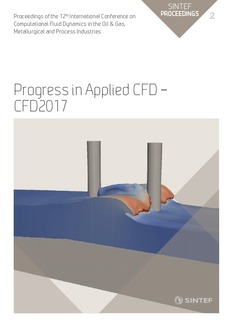| dc.contributor.author | Haddadi, Bahram | |
| dc.contributor.author | Jordan, Christian | |
| dc.contributor.author | Norouzi, Hamid R. | |
| dc.contributor.author | Harasek, Michael | |
| dc.date.accessioned | 2018-01-28T17:45:44Z | |
| dc.date.available | 2018-01-28T17:45:44Z | |
| dc.date.issued | 2017 | |
| dc.identifier.isbn | 978-82-536-1544-8 | |
| dc.identifier.issn | 2387-4295 | |
| dc.identifier.uri | http://hdl.handle.net/11250/2480090 | |
| dc.description.abstract | Packings are an inseparable part of Chemical Engineering processes like adsorption. Computational Fluid Dynamics (CFD) simulations on fully resolved packed beds can provide local flow information (e.g. wall effects and flow bypasses) which cannot be identified using ―black box‖ and/or onedimensional modelling, which can have severe influence on the adsorption characteristics. Creation of random packed beds is one of the main challenges in studying fully resolved packings; this can be covered using Discrete Element Methods (DEM). In this study the effect of using different types of particles on the fluid flow pattern in the packings was investigated. Three different types of particles (mono-disperse spheres, mono-disperse cylinders and poly-disperse cylinders) were packed into beds with identical dimensions (same height, same diameter) using custom DEM code and meshed using open source tools. CFD simulations were performed using adsorpFoam, a newly developed solver for modelling adsorption, based on open source CFD code OpenFOAM®. In this stage of study particles were considered as non-reactive to investigate fluid flow only. From simulated packings porosities as well as particle arrangements and positions have been analysed. Frequency and positions of high velocity spots were extracted. The residence time distributions were also analysed. Furthermore, experiments with the identical types of particles were performed to verify the validity of the packing structure and global simulation results. The pressure drops derived from simulations were compared to the measured values from the beds in the lab and also available correlations and a good agreement was observed. | nb_NO |
| dc.language.iso | eng | nb_NO |
| dc.publisher | SINTEF Academic Press | nb_NO |
| dc.relation.ispartof | Proceedings of the 12th International Conference on Computational Fluid Dynamics in the Oil & Gas, Metallurgical and Process Industries | |
| dc.relation.ispartofseries | SINTEF Proceedings;2 | |
| dc.subject | Computational Fluid Dynamics | nb_NO |
| dc.subject | Packed bed | nb_NO |
| dc.subject | Particle | nb_NO |
| dc.subject | Discrete Element Method | nb_NO |
| dc.subject | Bypass | nb_NO |
| dc.subject | Pressure drop | nb_NO |
| dc.subject | OpenFOAM® | nb_NO |
| dc.title | Numerical investigation of particle types influence on packed bed adsorber behaviour | nb_NO |
| dc.title.alternative | Progress in Applied CFD. Selected papers from 10th International Conference on Computational Fluid Dynamics in the Oil & Gas, Metallurgical and Process Industries | nb_NO |
| dc.type | Chapter | nb_NO |
| dc.type | Conference object | nb_NO |
| dc.type | Peer reviewed | nb_NO |
| dc.description.version | publishedVersion | nb_NO |
| dc.subject.nsi | VDP::Technology: 500 | nb_NO |
